There are multiple types of wasps in Texas. These are easily identified by the shape and color of their bodies.
Often confused with bees, Texas wasps have a smooth body without any hairs as they don’t collect pollen. Most wasps in Texas also have vivid coloring, unlike bees in the state.
Here are the most common Texas wasps and what makes them different.
Table of Contents
1. Guinea Paper Wasp
Typical and Variable Guinea Paper Wasps (Polistes exclamans) are found in the US. Texas Guinea Wasps are mostly part of the Typical sub-group.
They are recognized by a marked yellow propodeum (the first abdominal segment) and mesonotum (the middle part of a 3-segment insect). Yellow markings are also common on the head.
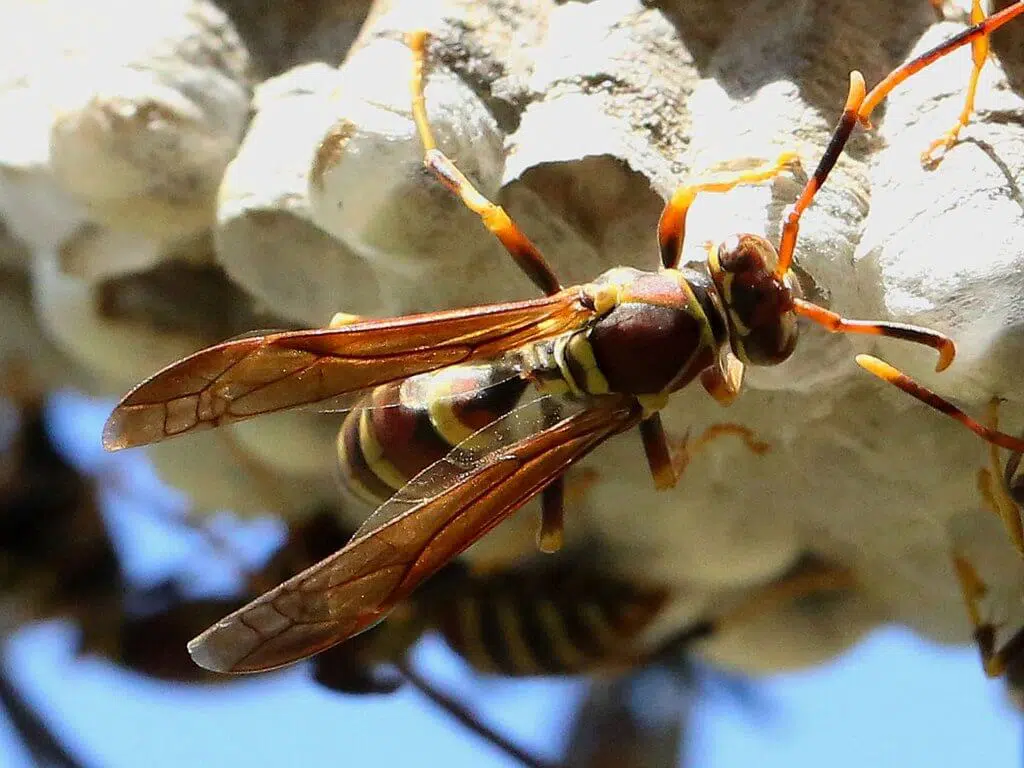
The Guinea Paper Wasps build nests near the building or in buildings. These nests are dominated by the queen who lays all the eggs, typically only inside the nest.
Guinea Paper Wasps are similar in their male and female appearance but they have different lifespans. A worker wasp of the species lives up to 16 days while the queen lives up to 6 times longer.
Premature death is among the most common threats of the species together with parasites. Some defense mechanisms are put in place by these wasps to protect against parasites.
2. Yellow-legged Mud-dauber Wasp
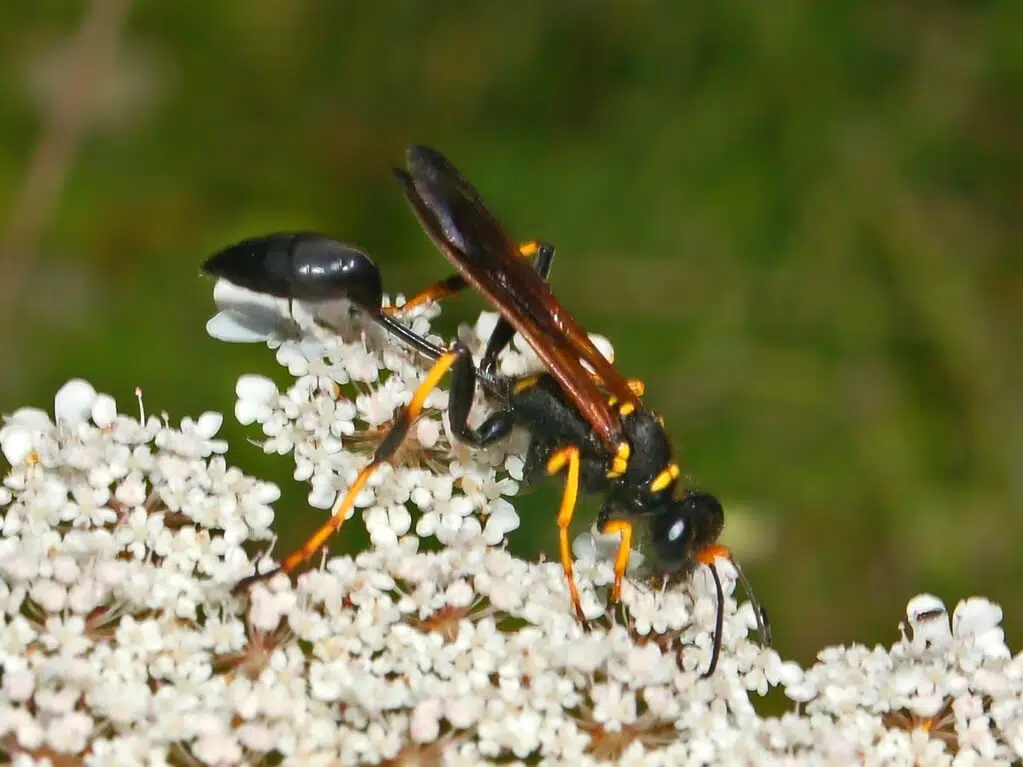
This wasp (Sceliphron caementarium) is part of the sphecid family. Its name is derived from the Latin word of ‘builder’ or ‘builder of walls’.
It can be recognized by its black petiole which is rarely yellow, particularly for the sub-species living in desert climates.
These wasps live on their own. They build their nests, typically out of the mud. This is why the species is sometimes referred to as the ‘mud wasp’.
These wasps are normally seen in the summer months when they like to eat various flower nectars. A common flower the Yellow-legged Mud-dauber Wasp is seen around is Queen Anne’s lace.
These wasps are also prolific breeders. The female lays eggs in mud nests where she deposits several spiders as prey for the emerging wasps. The female never returns to the place she lays eggs.
3. Eastern Cicada-killer Wasp
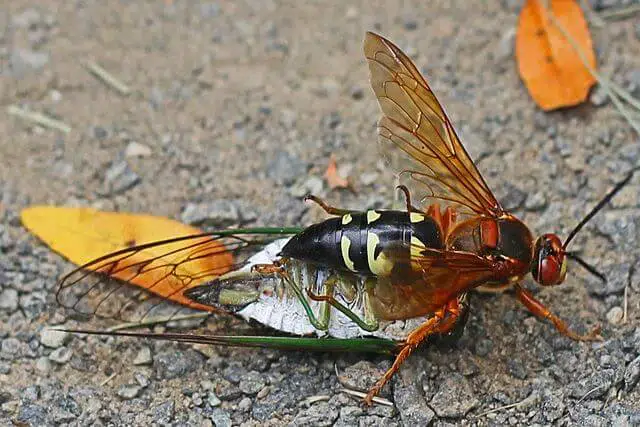
This solitary wasp (Sphecius speciosus) is instantly recognizable given its large size. It reaches a maximum size of 2 inches, making it one of the largest types of wasps in Texas.
Despite its size, the wasp isn’t particularly aggressive towards humans. Mild handling will not lead to a sting. Aggressive handling will eventually prompt these wasps to bite.
The wasps can be further identified by their black-red body with yellow stripes. They have brown wings and they are seen frequently, especially the males of the very territorial species.
Most male Eastern Cicada-killer wasps quickly investigate possible threats to the female or possible males looking to mate with the female.
4. Hunter’s Little Paper Wasp
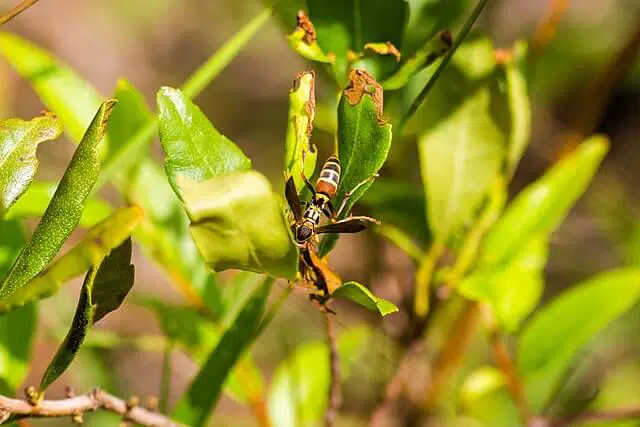
The small wasp only reaches the size of 11-12mm. As one of the smallest wasps in Texas, the Hunter’s Little Paper Wasp (Polistes dorsalis) still has a lot of significance. First, it’s believed its venom has antimicrobial action which recommends it for further scientific identification.
These wasps are social which means they live and work together as a team. The female Hunter’s Little Paper Wasps work together to create a colony.
Many of these colonies are run by multiple females while others are run by a queen female, a role typically given to the largest female in the colony. They lay eggs and look for food.
Each colony is dominated by a large female until new wasps emerge or until the queen dies. Another female quickly assumes the role of the queen in case the queen dies.
5. Metric Paper Wasp
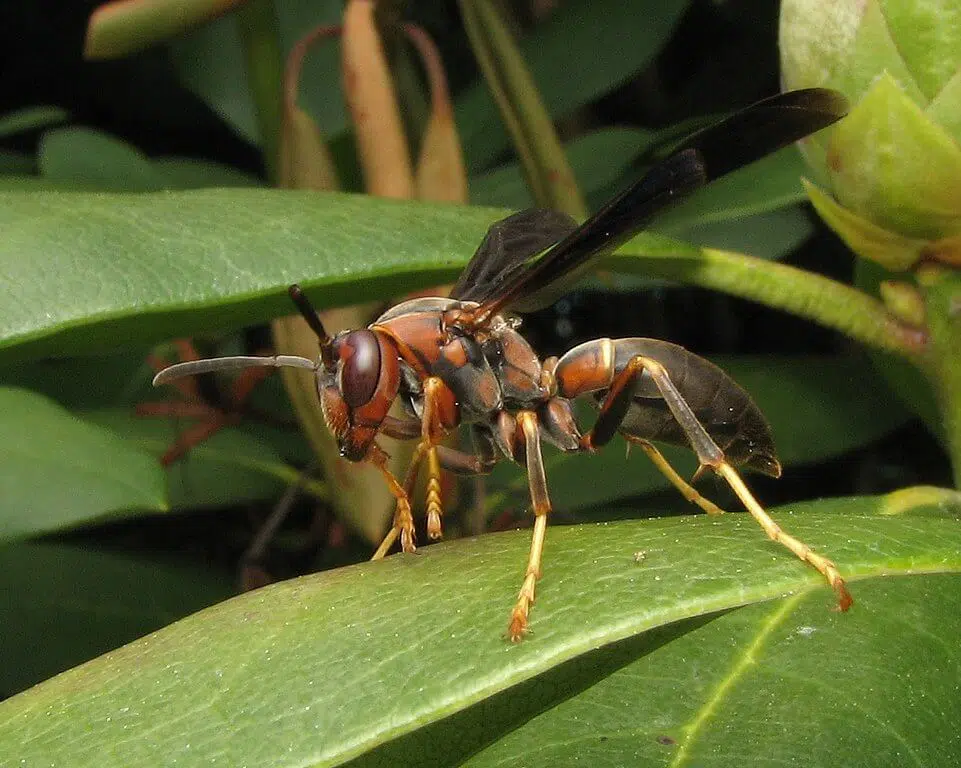
The Metric Paper Wasp (Polistes metricus) is instantly recognizable by its rusty-red body. Yellow markings are rare and are typically only seen on its head.
This social wasp is known to work together in creating colonies. A dominant female or multiple dominant female wasps are responsible for laying eggs inside the colony.
Most colonies of the Metric Paper Wasp are found in sheltered areas with plenty of light and near water sources. They are frequently seen in barns.
These wasps are also highly efficient at laying eggs together with other species of wasps.
The intensity of the building effort is typically high. This is why these wasps return to the same colony for the next breeding season.
The highest number of wasps or the peak population times for Metric Paper Wasp colonies are in early June and early July.
6. Apache Paper Wasp
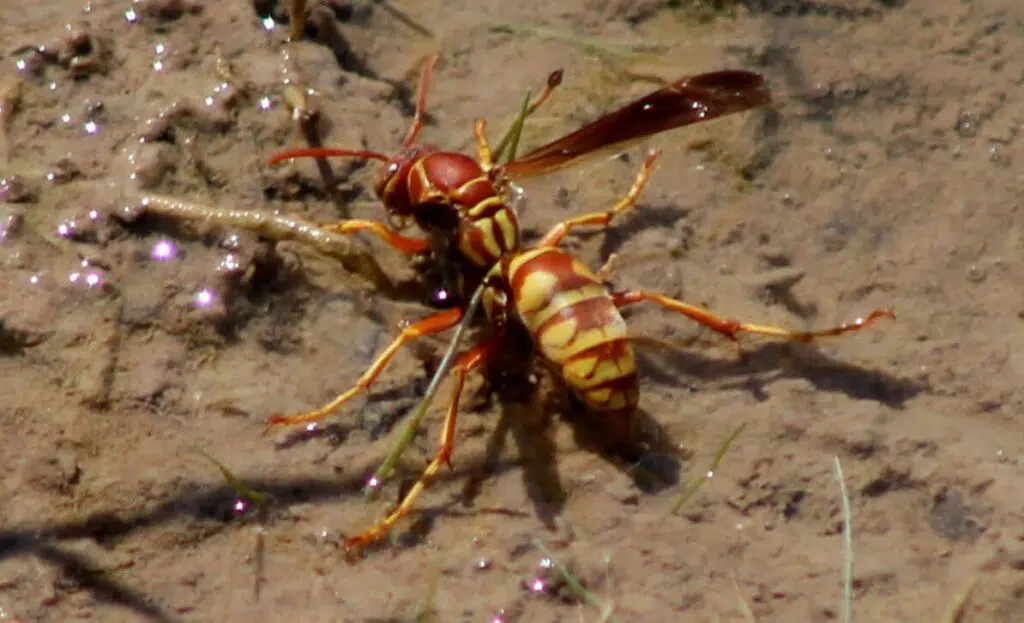
The Apache Paper Wasp (Polistes apachus) has a brown-yellow body. It’s largely found in Texas and areas of New Mexico, California, and Mexico. This species grows to a size of up to 20mm. It’s mostly known for a species that builds large nests with up to 320 cells.
A female assumes the dominance of these large nests. Other fertile females help establish the nest. They are believed to have a supporting role for the dominating female. These females are also the wasps that help the dominating female build the nest.
Small pieces of wood or other wood fibers are used to build the nest. These wasps are very specific to the type of wood they use to build these nests typically only using one piece of wood if it’s good enough for the nest where all wasps come to for more wood fibers.
7. Southern Yellowjacket
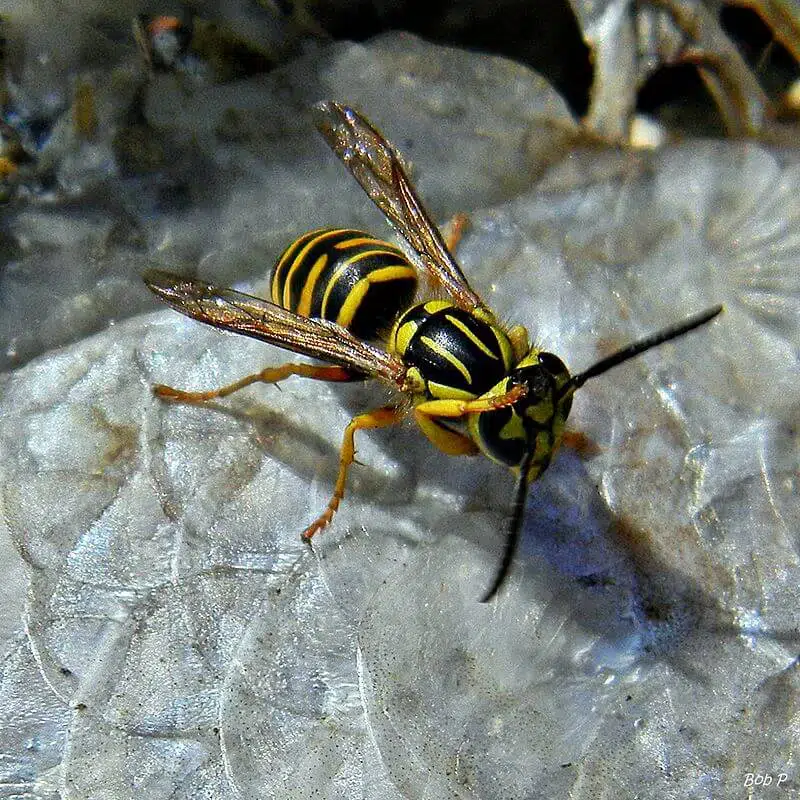
These wasps (Vespula squamosa) are known for their Texas and Central American distribution. They are some of the most feared wasps as they form nests where they bring all types of food.
These wasps are sometimes seen eating nectar. But they also eat other insects. The Southern Yellowjacket wasp has also been seen eating dead animals.
The wasps build nests in early spring. They use their mouths to remove wood fiber from pieces of wood or from plants which are repurposed into building materials for the nest. These nests or colonies can reach thousands of insects.
8. Fine-backed Red Paper Wasp
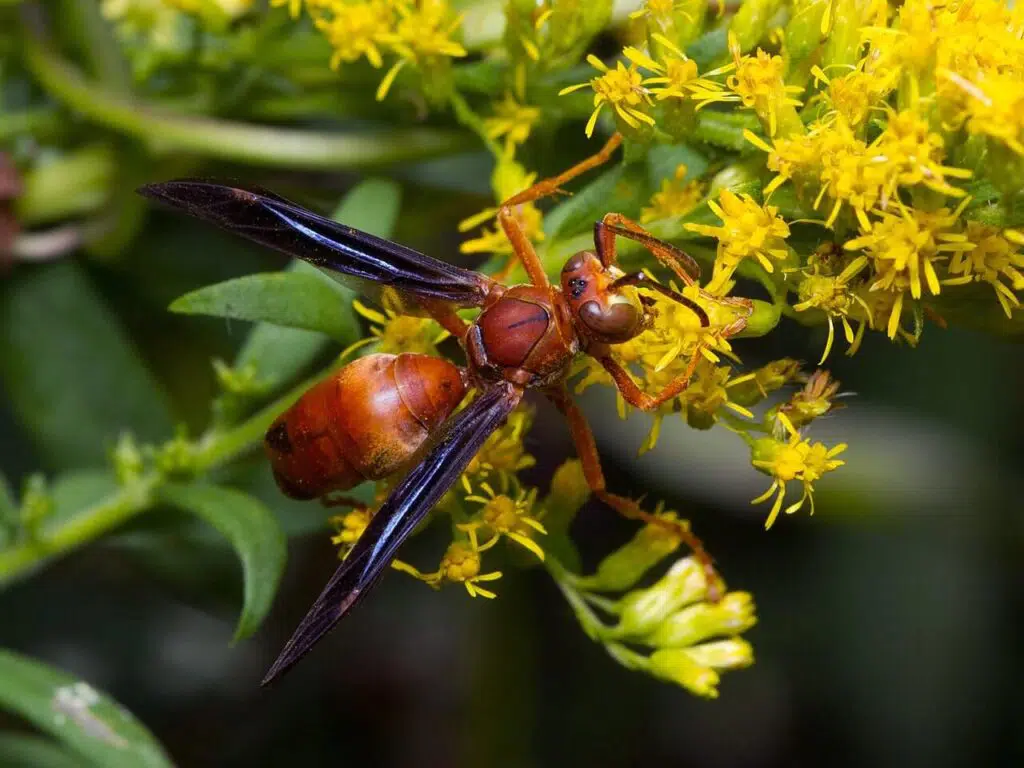
The Fine-backed Red Paper Wasp (Polistes carolina) has an iron-red color that resembles rusty iron. This visual identity is specific to females as the male wasps have darker color bodies. Yellow markings have been spotted on these wasps, but they are generally rare.
Like other paper wasps, there’s a lot of wood and plant fiber used in the creation of colonies. Chewed pieces of wood and plants make an umbrella-like nest with a honeycomb opening at the bottom.
These wasps are known for a limited diet. They mainly eat nectar and caterpillars.
9. Great Golden Digger Wasp
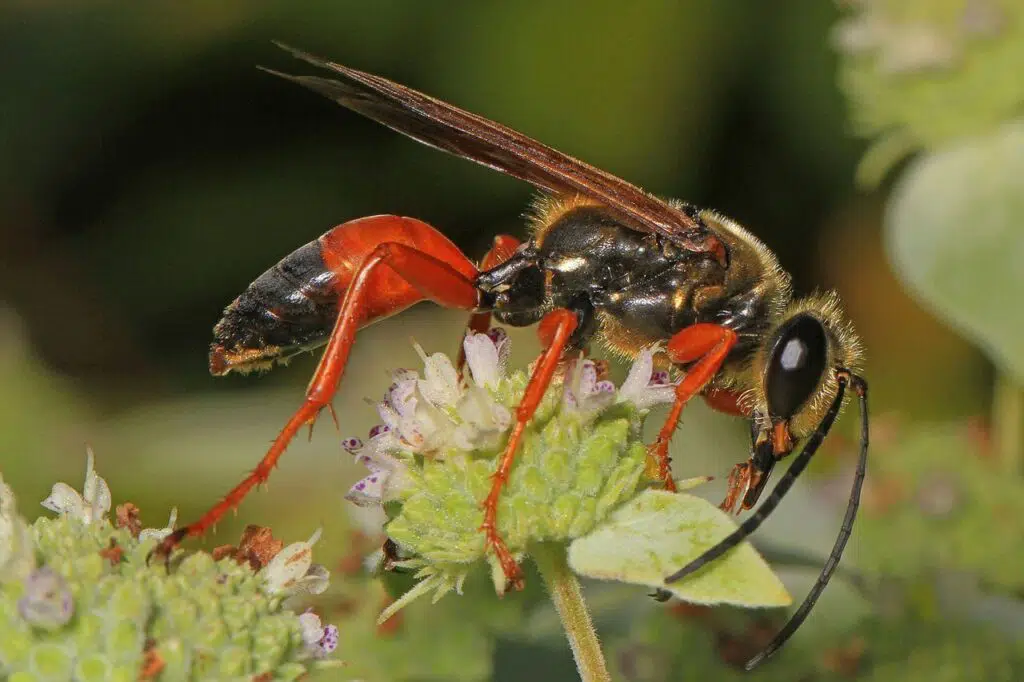
This digger wasp (Sphex ichneumoneus) is unique. It digs holes into the ground for its eggs and covers them up to close off potential threats to the eggs. Before closing each hole in the ground, the wasp must also catch insects to drop an egg on in the ground hole for the larvae to feed on.
As the Great Golden Digger Wasp stings insects, it paralyzes them but it doesn’t kill them.
The female wasp then has to carry the insect to the ground hole where it lays an egg on top of it for each hole.
However, the wasp’s caught insect is seen as prey by birds. This is not common for other digger wasp species. The survival of this species depends on the successful evading of the female wasps and staying away from the attacks of birds such as robins interested in their prey.
10. Blue-eyed Ensign Wasp
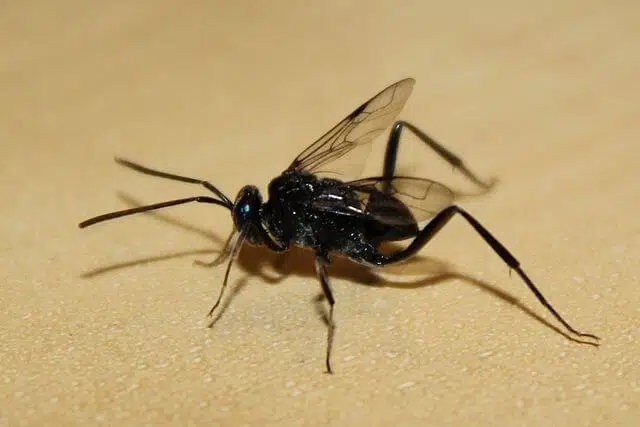
The Blue-eyed Ensign Wasp (Evania appendigaster) gets its name from its large blue eyes. This wasp is part of the Evaniidae family.
Its origins are unknown. Most researchers believed it arrived in Texas and the US from Asia. The species is known for its beneficial role in preventing cockroach populations.
The wasp has to kill one cockroach for each egg it lays. The eggs are laid on cockroaches so that the larvae have sufficient food to fully develop.
This is why the Blue-eyed Ensign Wasp is often raised in laboratories. It’s later released in areas where cockroaches create trouble, particularly in agricultural areas.
11. Ringed Paper Wasp
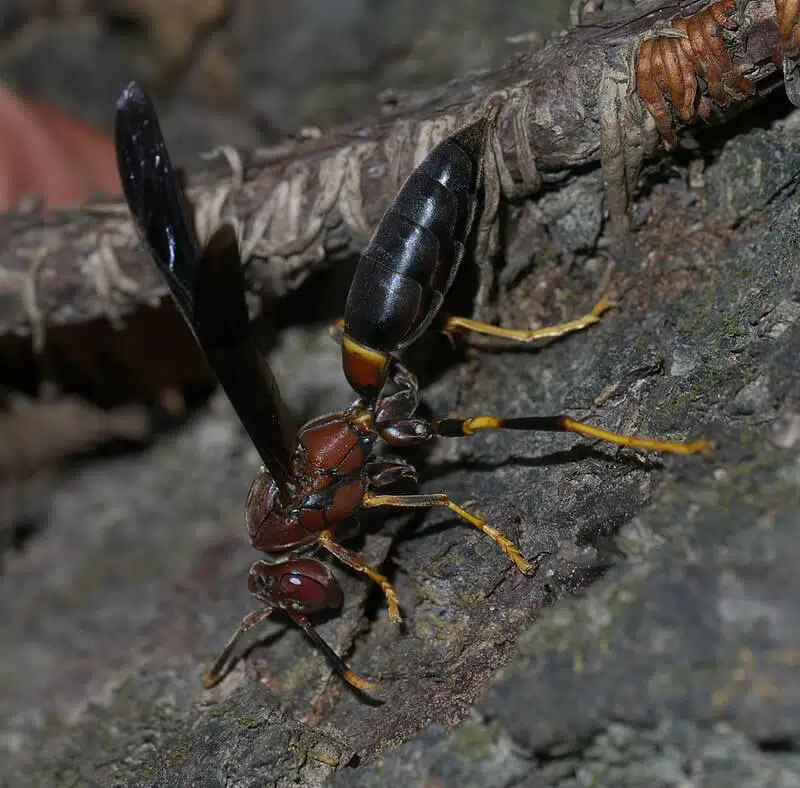
This wasp (Polistes annularis) is known for its love of dark places. It has a brown and black body which almost makes it hard to see in certain areas. This dark color body is believed to be an adaptation to its habitat as it prefers to build nests away from direct sunlight.
The wasp has plenty of natural predators. Ants are believed to be its biggest enemy.
But these wasps are also some of the most resilient in the state as they can survive difficult cold weather climates in the winter. The wasp is also shown to prepare food for winter, particularly by storing honey in advance.
12. Red-marked Pachodynerus Wasp
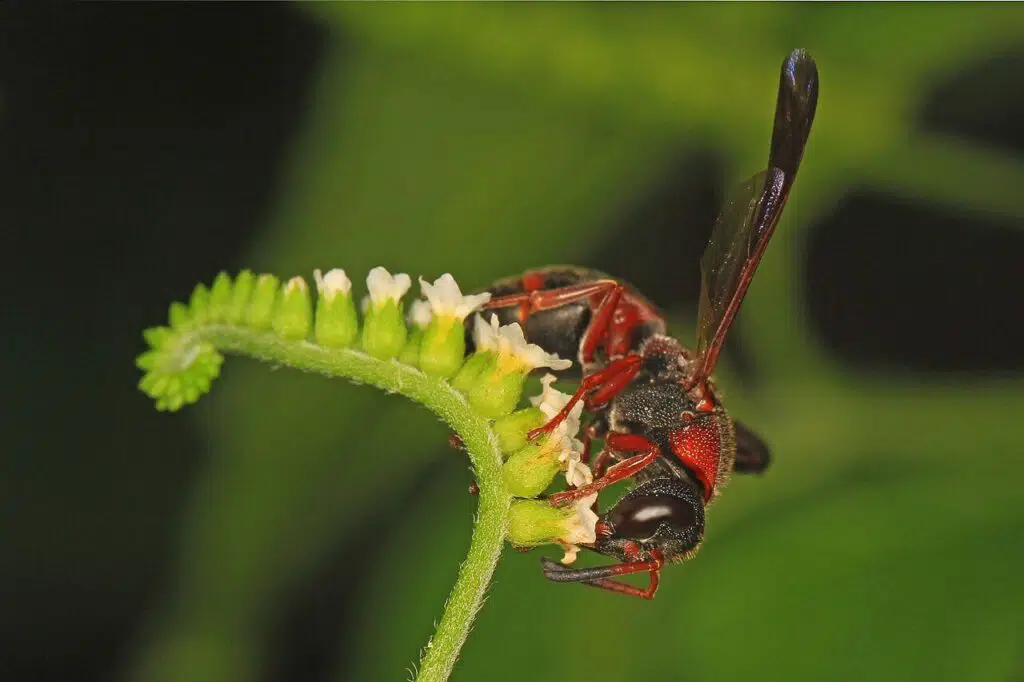
The Red-marked Pachodynerus Wasp (Pachodynerus erynnis) is known to live near homes or out in nature near water sources.
It sometimes creates shelter in walls, particularly between bricks and in crevices. But this species of wasps are also known for its dedicated mud-building nest skills.
Dirt and saliva are mixed by the female soon after mating to build a shelter for the eggs. These shelters are often rebuilt and repurposed from one season to another.
These shelters aren’t as good-looking as others from other wasp species as they are primarily made from dirt. But the shelters are large enough for one egg and one caterpillar deposited for the larvae.
13. Nearctic Blue Mud-dauber Wasp
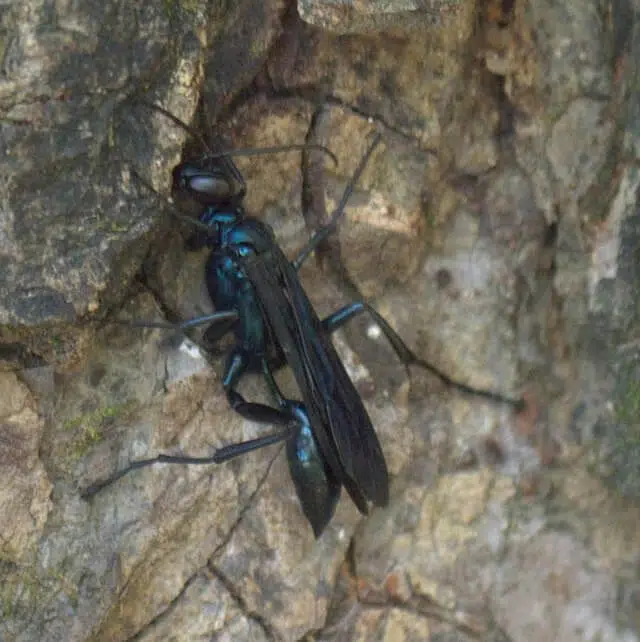
This wasp (Chalybion californicum) has distinct shiny dark blue coloration. While not as common as other wasps in Texas, it’s easy to recognize due to its all-blue coloration. The wasp is also known as one of the few natural predators of the poisonous Black Widow spider.
Nearctic Blue Mud-dauber wasps live in solitude. The female builds her nests to lay eggs in. The female wasp might also sting potential predators such as other wasps or small birds to protect the eggs. The male wasp doesn’t have a sting capacity on the other hand.
14. Fraternal Potter Wasp
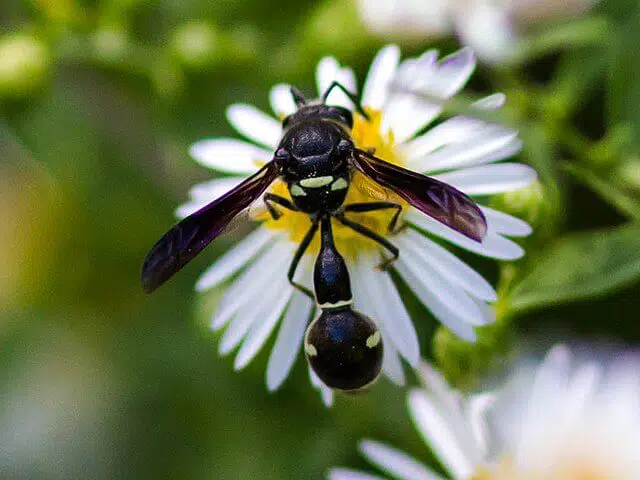
The Potter Wasp (Eumenes fraternus) has a long slender body. Its first segment is the thinnest. These wasps grow to a maximum size of 20mm.
They can be recognized by their unique mating method which involves creating small mud structures that resemble pots to lay eggs in.
The female Fraternal Potter Wasp is responsible for laying eggs in these mud creations. Water particles are collected and mixed with dirt in a process that can last up to a few hours. The final result is a pot-shaped circular construction where the female inserts the abdomen to lay an egg.
Mud pots need to be large enough to accommodate an egg as well as a living caterpillar as a food source for larvae.
15. Four-toothed Mason Wasp
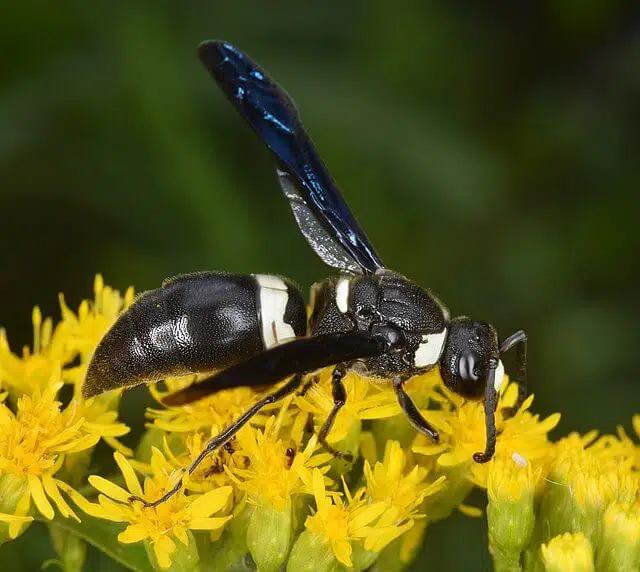
This wasp (Monobia quadridens) species also grows to a similar size of up to 18mm. It has sufficient distinct characteristics to be easily identified. For example, it’s one of the few wasp species in Texas where both sexes can sting.
Both the male and the female wasp can sting humans. While this happens rarely, the sting is painful, often associated with the pain of the bald-faced hornet sting.
This species also reproduces more than others. A calendar year is bi-generational which means two generations of Four-toothed Mason Wasp are born each year. One generation is born in the summer while the other is born in early spring.
16. Wool-bearing Gall Wasp
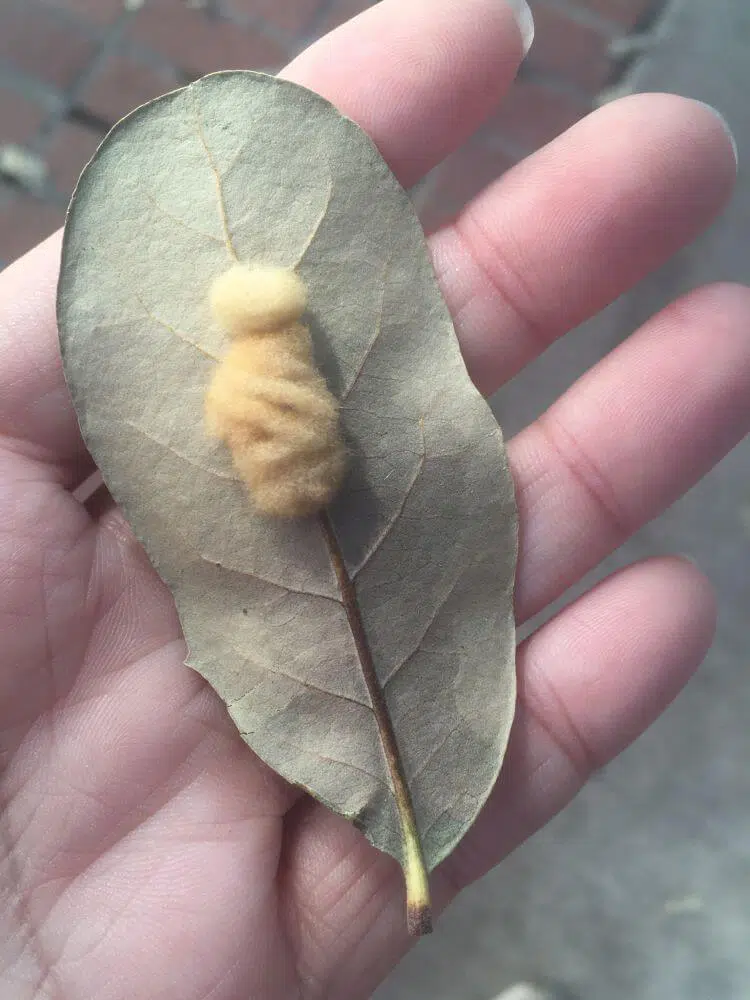
Gall wasps are some of the smallest in Texas. This distinct species (Andricus quercuslanigera) only measure a few millimeters sometimes being hard to see.
As their name suggests, they live in wool-like shelters. These are common around oak trees and oak forests.
It’s believed hundreds of Gall wasps can live on an oak tree. It’s estimated it can take up to 3 years for Gall wasps to fully develop in their wool shelters.
17. Spongy Oak Apple Gall Wasp
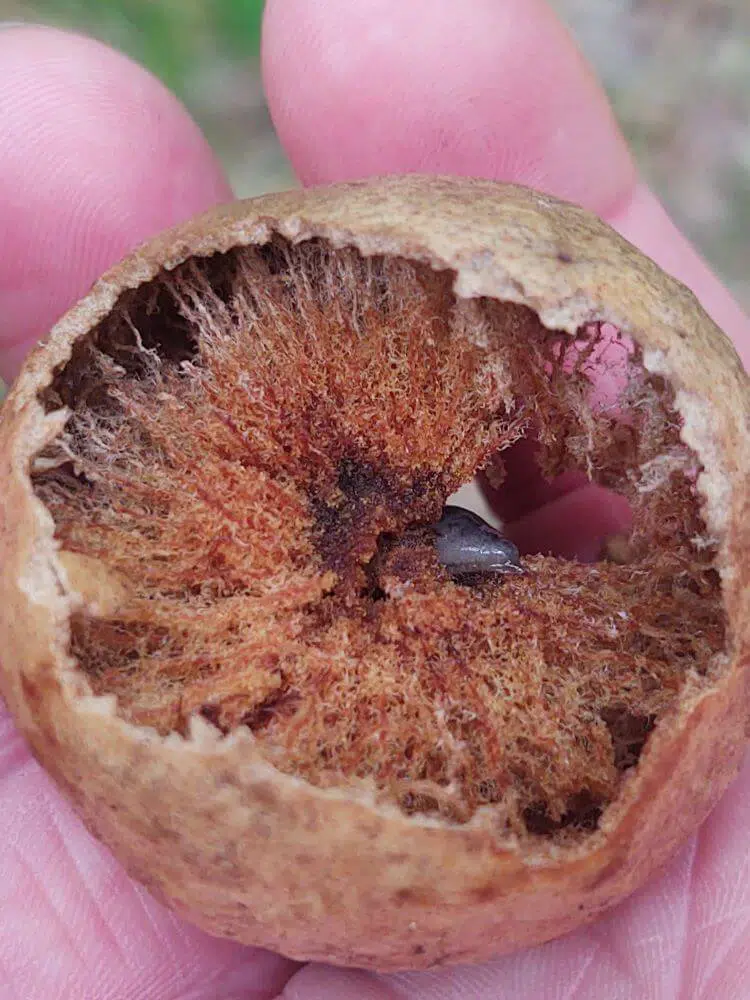
Spongy Oak Apple Gall wasps (Amphibolips confluenta) aren’t as studied as other species of wasps in the state. However, they have been identified in oaks around the state, often on the same branch and more numerous the leaves of a tree.
These wasps lay ball-shaped larvae, They appear as fruits from a distance. This larva is green but it turns tan in time before the wasp emerges.
Some of these larvae are found on oaks around the state. But prefer trees are red oaks and scarlet oaks.
18. Coarse-backed Red Paper Wasp
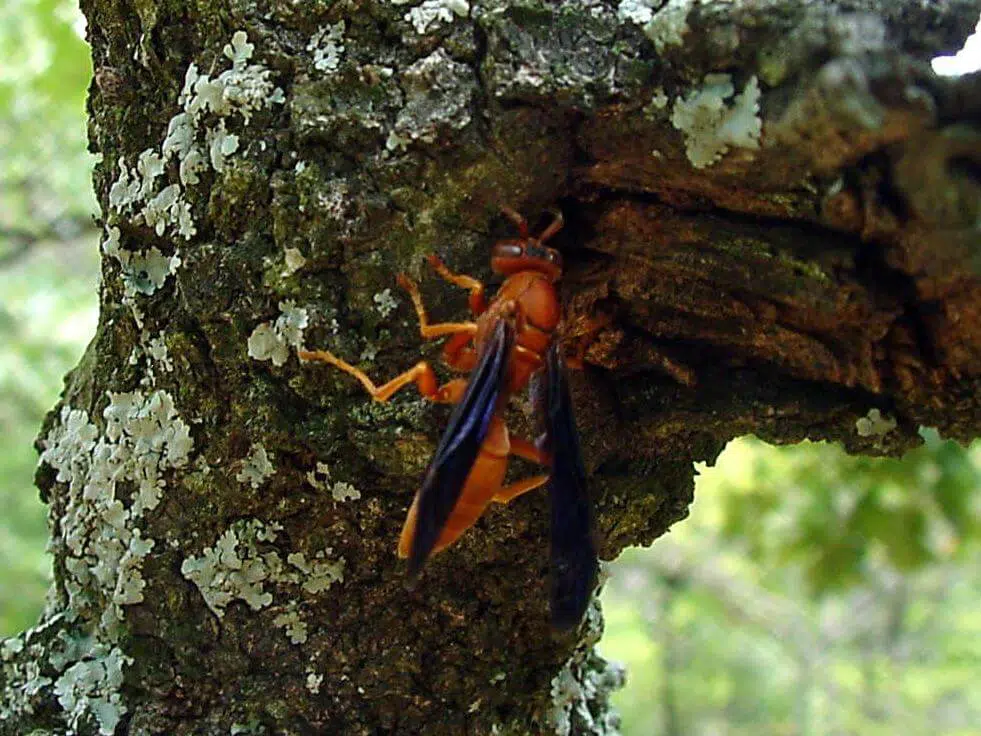
The Coarse-backed Red Paper Wasp (Polistes rubiginosus) is one of the 2 species of Red paper wasps. It has a dark-rust color with darker areas towards body extremities.
The female of the species is larger than the male wasp. It’s not unusual to see a female Coarse-backed Red Paper wasp reach a length of 21.5mm. However, many females in food-scarce areas only reach 18mm in length.
Male wasps are a few millimeters shorter. The largest Coarse-backed Red Paper male wasp measures around 18mm while the smallest only measures around 17mm.
Both the male and the female Coarse-backed Red Paper Wasp have distinct markings around the eyes. These dark markings surround the eyes and they are rarely separated into 2 circles. They are normally joint markings surrounding the eyes of the wasp.
19. Metallic Bluish-green Cuckoo Wasp
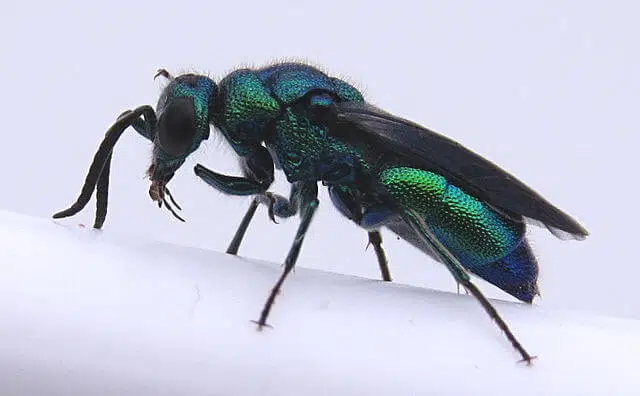
The Metallic Bluish-green Cuckoo Wasp (Chrysis angolensis) is a species of parasitic wasps in Texas and a few other US areas. It’s not native to the continent as it’s believed to have arrived in North America with World War II ships.
As any other parasitic wasp, it needs the shelter of other wasps to develop.
The female wasp lays eggs in wasp shelters before they are closed. The larvae of the species develop together with the larvae of non-parasitic wasps in the state.
Apart from the blue color of these wasps, they can further be identified by their defense mechanisms. This parasitic wasp frequently curls up into a ball to avoid being eaten by predators.
20. Mexican Honey Wasp
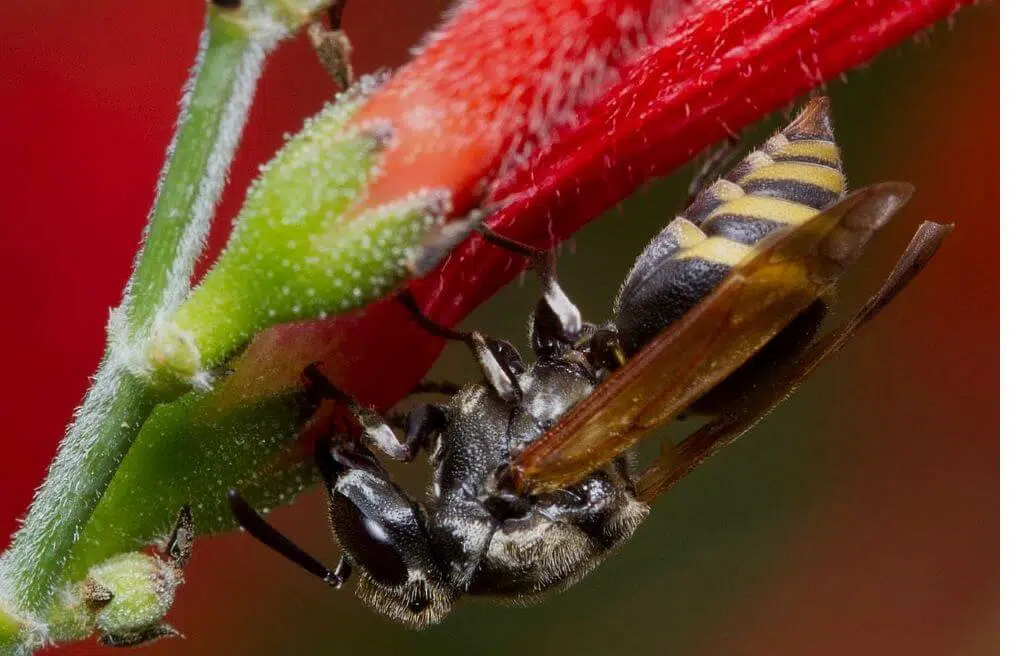
This wasp species (Brachygastra mellifica) is native to Mexico but it also makes its way to Texas. It’s one of the few honey-making species of wasp which allows it to be a productive species.
However, it’s mostly used in agricultural fields where it has high pollination potential. The wasp helps pollinate avocado fields. They carry pollen on their abdomen.
Most other wasps can’t do these as they don’t have small hair follicles on their lower body.
21. Mealy Oak Gall Wasp
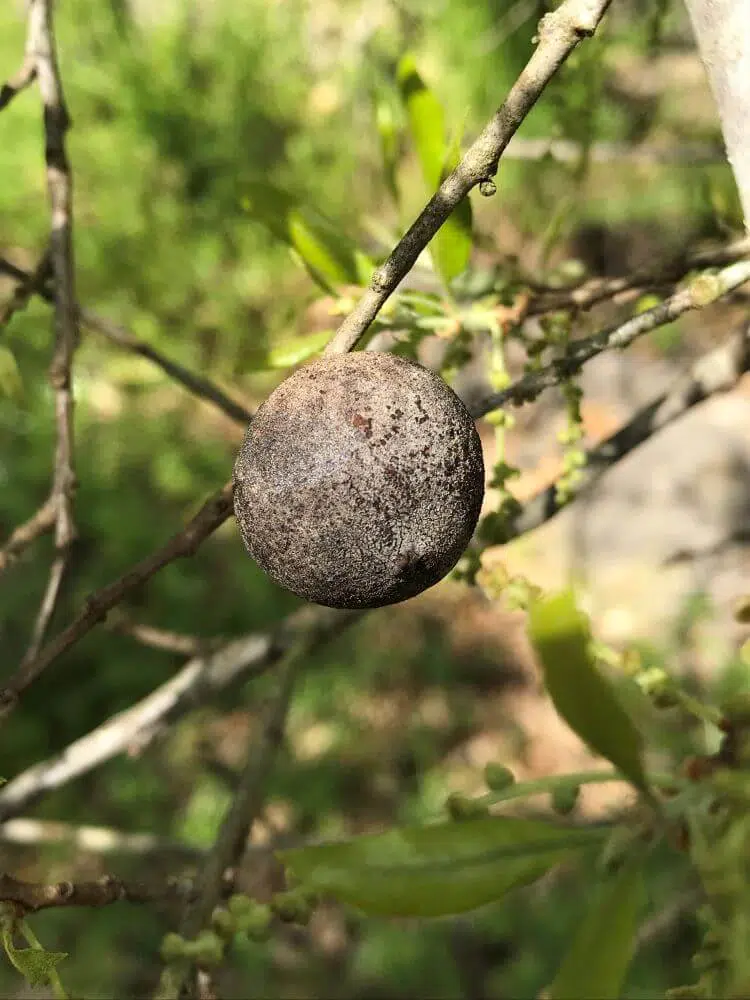
Living on oak trees, these Gall wasps (Disholcaspis cinerosa) are known to emerge twice per year.
The distinct characteristic about this is that the wasps are the first asexual when emerging in December to January. They are then born as both males and females but typically a lot smaller than the first generation of Gall wasps born earlier that year.
Many people try to get rid of this species of Gall wasps. But they are generally beneficial around the house. They hunt and eat almost all types of insects that live around households.
22. Dark Paper Wasp
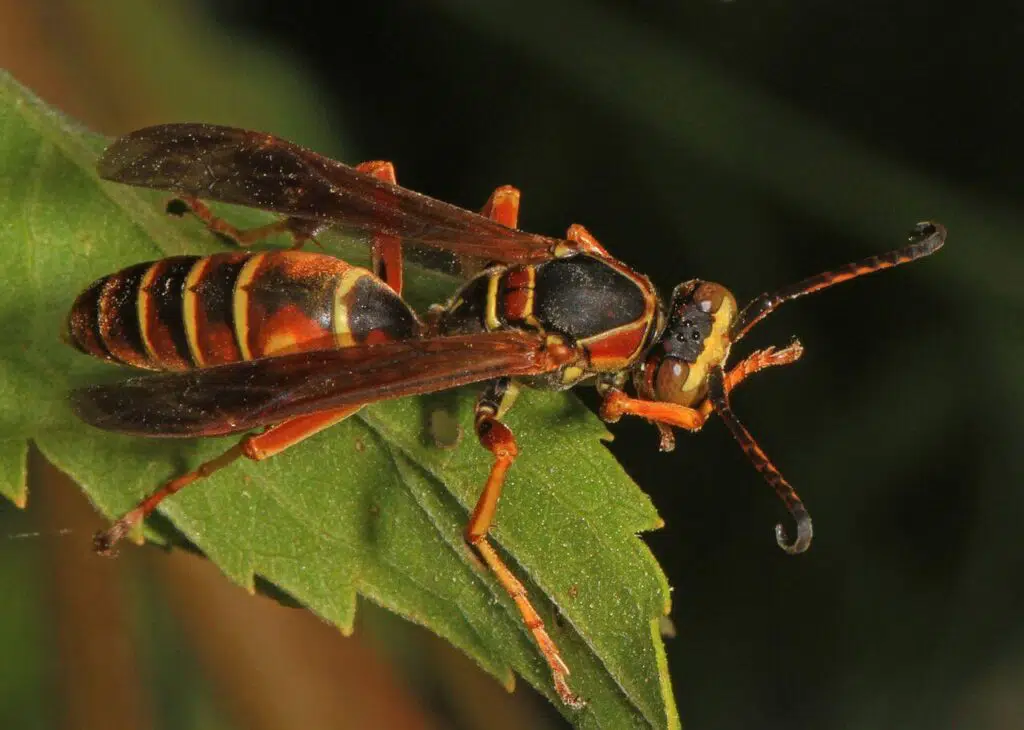
The Dark Paper Wasp (Polistes fuscatus) lives in colonies and habitats dominated by a clear hierarchy. The queen is the female wasp ruling a colony or a shelter.
These wasps are highly intelligent and typically very good at defending a colony against parasite wasps.
The wasps often attack parasite wasps or other species of wasps trying to enter the colony. It’s believed the Dark Paper Wasp can identify wasps that aren’t part of the colony by the way they fly.
Most wasps approaching the colony do so in a clear way with a clear purpose. Wasps that aren’t part of the colony normally fly without a clear direction. This is also the habit that gives them away often leading to multiple attacks from defending Dark Paper wasps.
23. Great Black Digger Wasp
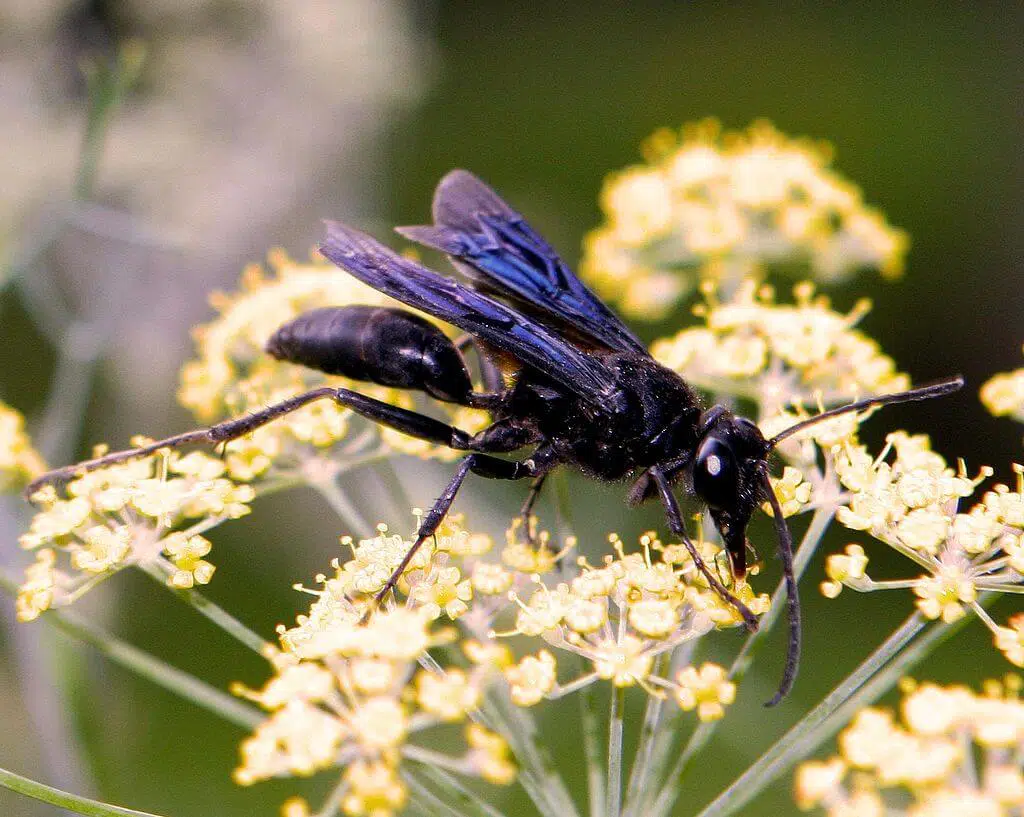
The Great Black Digger wasp (Sphex pensylvanicus) is a pollinator species for plants such as milkweeds. These wasps are some of the most agile large wasps in the state as they have very efficient preying techniques that allow them to capture almost any insect.
The wasps are known for stinging insects 3 times. They sting once behind the head and twice in the abdomen of the insects.
These insects can survive a series of 3 stings for weeks as they’re only paralyzed and not killed. The wasps then have to transport the paralyzed insects to their shelters but birds often try to catch the insects in the meantime.
Many wasps have no pollination benefits. But the Great Black Digger is one of the few common milkweed pollinators.
24. Common Thread-waisted Wasp
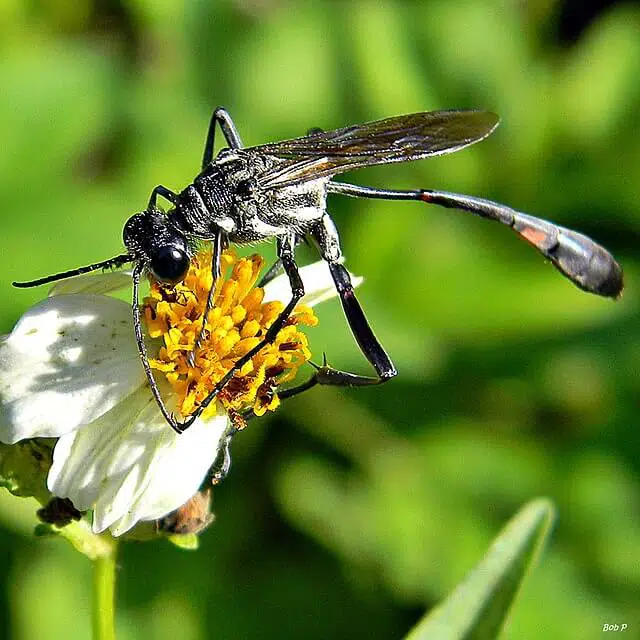
The Common Thread-waisted Wasp (Ammophila procera) lives in sandy areas and habitats with soft soil.
Its mating habits dictate its habitat as the female wasp needs to dig burrows in the ground and to lay eggs inside. The female then seals the nest memorizing its location by analyzing the nearby surrounding.
The next few days are marked by the female’s efforts trying to find food. The female wasps look for caterpillars which are brought back to the eggs burrows inside the ground. Other female wasps can use these burrows to lay their eggs as well. All eggs hatch within a couple of days so larva needs sufficient food to survive.
25. Eastern Yellowjacket
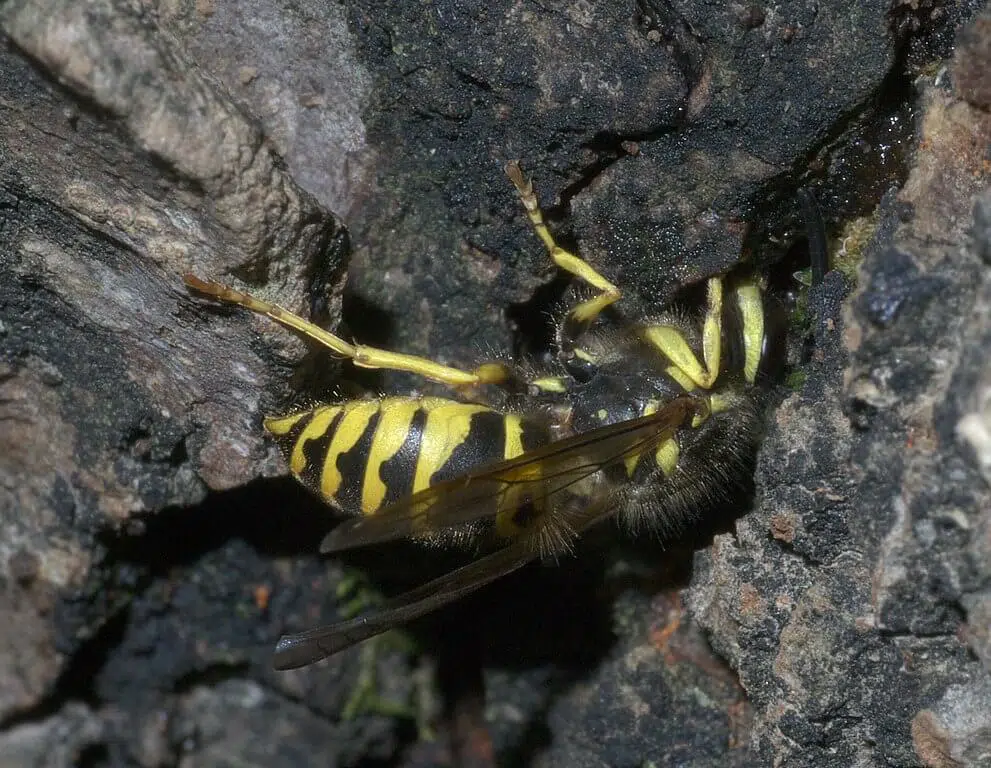
The Eastern Yellowjacket (Vespula maculifrons) looks similar to bees. These wasps live in colonies or hives where there are 3 common hierarchies.
The first hierarchy is the queen, solely responsible for laying eggs. The second hierarchy is worker wasps that constantly move around repairing and expanding the colony’s nest which can shelter up to a few thousand wasps. The third hierarchy is comprised of male wasps.
All of these wasps (except the female) work together to keep all predators away as much as possible. They even communicate with each other in face of danger.
It’s believed these wasps release a special type of pheromone only when there’s a potential predator around the colony which needs to be killed. The wasps then form an attacking formation first circling the nest. They then slowly move towards the perceived threat flying in a zig-zag pattern.
Interestingly, common parasite wasps which may be found inside the nest are also activated during this pheromone release signaling possible common communication techniques.
Further Reading: